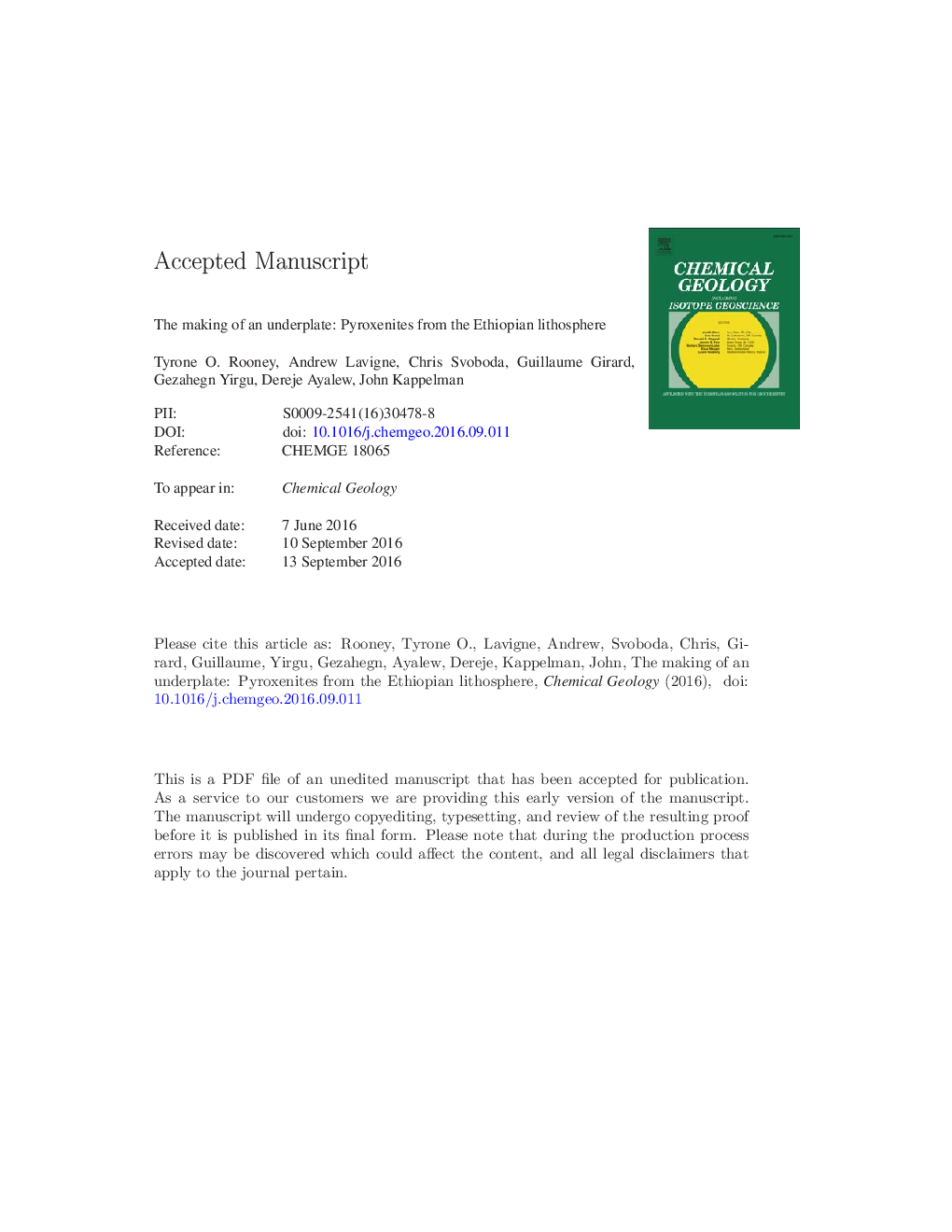| کد مقاله | کد نشریه | سال انتشار | مقاله انگلیسی | نسخه تمام متن |
|---|---|---|---|---|
| 5782741 | 1637519 | 2017 | 63 صفحه PDF | دانلود رایگان |
عنوان انگلیسی مقاله ISI
The making of an underplate: Pyroxenites from the Ethiopian lithosphere
دانلود مقاله + سفارش ترجمه
دانلود مقاله ISI انگلیسی
رایگان برای ایرانیان
کلمات کلیدی
موضوعات مرتبط
مهندسی و علوم پایه
علوم زمین و سیارات
ژئوشیمی و پترولوژی
پیش نمایش صفحه اول مقاله

چکیده انگلیسی
Magmatic underplates, which are characterized by high seismic velocity and anomalously high density in comparison to normal lower crust, are among the most significant compositional heterogeneities identified in the rift lithosphere. The interaction of a magma with the lithospheric mantle to form pyroxenites is considered a viable mechanism for the creation of an underplate, though the details of such interaction are difficult to constrain with geophysical techniques alone. Here we present a petrographic and geochemical study of pyroxenite xenoliths erupted on the western Ethiopian plateau from along the Yerer Tullul Wellel Volcano-Tectonic lineament (YTVL). The equilibration pressures recorded by the xenoliths (0.88-1.49Â GPa) are consistent with an origin within a seismically and gravitationally defined underplate that exists beneath the western Ethiopian plateau. Three groups of pyroxenite have been identified: Group I - characterized by a relative enrichment of orthopyroxene, and clinopyroxene with unfractionated heavy rare elements (HREE; TbN/YbNÂ =Â 1.2-1.6); Group II - characterized by a relative enrichment in clinopyroxene, which have fractionated HREE (TbN/YbNÂ =Â 1.6-2.0); Group III - transitional xenoliths that contain pyroxene characteristic of Group I but also contain clinopyroxene characteristic of Group II. The magma responsible for the formation of Group I xenoliths was likely of sub-alkaline composition and derived from a spinel peridotite on the basis of relatively unfractionated REE profiles. This magma may have been the Oligocene Low Titanium (LT)-type flood basalts associated with the Afar plume, or subduction-related magmatism associated with island arc activity during the construction of the regional lithosphere during the Neoproterozoic Pan African Orogeny. The magma responsible for the formation of Group II xenoliths was likely of alkaline composition and derived from a source with some garnet on the basis of fractionated HREE. This magma may have been the Oligocene High Titanium (HT)-type flood basalts associated with the Afar plume or Miocene-recent magmas associated with the reactivation of the YTVL during rift development. Our results show that the lithospheric mantle beneath the YTVL was impacted by at least two metasomatic events and exhibits characteristics more similar to the xenolith suites from the rift valley than elsewhere on the western Ethiopian plateau. We propose that the magmatic underplate beneath the western Ethiopian plateau was formed by multiple episodes of magma-lithosphere interaction, likely developing over time rather than in a single event.
ناشر
Database: Elsevier - ScienceDirect (ساینس دایرکت)
Journal: Chemical Geology - Volume 455, 20 April 2017, Pages 264-281
Journal: Chemical Geology - Volume 455, 20 April 2017, Pages 264-281
نویسندگان
Tyrone O. Rooney, Andrew Lavigne, Chris Svoboda, Guillaume Girard, Gezahegn Yirgu, Dereje Ayalew, John Kappelman,